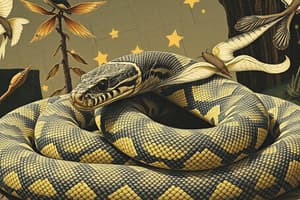Podcast
Questions and Answers
What animal does the narrator initially draw in his pictures?
What animal does the narrator initially draw in his pictures?
A big snake.
Why does the narrator stop wanting to make pictures?
Why does the narrator stop wanting to make pictures?
People tell him that it's better to study subjects like geography, history, and maths.
What profession does the narrator have as an adult?
What profession does the narrator have as an adult?
He is a pilot.
What happens to the narrator in the Sahara Desert?
What happens to the narrator in the Sahara Desert?
What does the little man ask the narrator to do?
What does the little man ask the narrator to do?
What does the little man request the narrator to draw?
What does the little man request the narrator to draw?
How does the little man respond to the narrator's first drawing of a sheep?
How does the little man respond to the narrator's first drawing of a sheep?
What conclusion does the little man draw about the sheep's needs?
What conclusion does the little man draw about the sheep's needs?
What does the narrator ultimately draw to satisfy the little man's request?
What does the narrator ultimately draw to satisfy the little man's request?
What does the little man say about the size of the sheep drawn by the narrator?
What does the little man say about the size of the sheep drawn by the narrator?
Flashcards are hidden until you start studying
Study Notes
Overview
- A six-year-old child observes a picture of a big snake in a book, which depicts the snake eating an animal and sleeping for six months.
- Inspired, the child creates two pictures: the first illustrates a snake with an elephant inside, while the second shows the inside of the snake.
- Upon sharing the pictures, others deem the child's art unworthy, favoring subjects like geography, history, maths, and grammar.
Transition to Adulthood
- The protagonist grows up to become a pilot, flying planes worldwide.
- Geography proves essential, especially in emergencies, like being lost at night.
- Despite adult responsibilities, the protagonist clings to the childhood picture, seeking understanding from others, who merely perceive it as a hat.
Crisis in the Sahara Desert
- An accident occurs in the Sahara Desert, leaving the protagonist stranded miles from civilization.
- With limited water supply, the protagonist faces a life-threatening situation while trying to repair the plane.
Encounter with the Little Prince
- The protagonist meets a mysterious little man in the desert who inexplicably requests a sheep to be drawn.
- Initially frustrated, the protagonist tries to draw but only knows how to depict a snake.
- The little man insists on a sheep rather than the dangerous snake or the elephant it contained.
Drawing Attempts
- After several unsuccessful attempts to draw a suitable sheep:
- The first attempt is rejected as it depicts a ram instead.
- The second sheep is deemed too old.
- Finally, the protagonist presents a box with a sheep inside, which pleases the little man.
Understanding the Little Prince
- The little prince, who appears unfazed by the desert surroundings, engages in various questions, hinting at a deeper understanding of life.
- The protagonist learns about the little prince's home and their conversations reveal significant insights, despite the prince’s reluctance to answer some questions.
Themes and Insights
- The narrative underscores the innocence of childhood creativity confronted by adult practicality.
- A significant theme revolves around perception and understanding: adults often overlook the simple truths seen by children.
- The storyline hints at the importance of imagination and the need for connection in understanding life’s complexities.
Studying That Suits You
Use AI to generate personalized quizzes and flashcards to suit your learning preferences.




